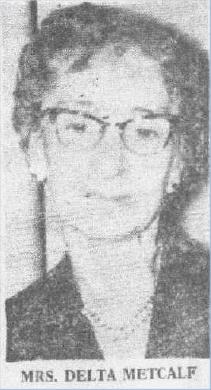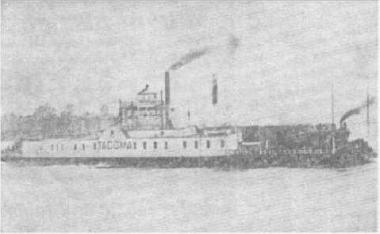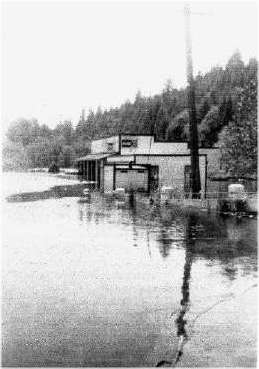| History of Goble Tavern! |

Of Once-Booming Hamlet of Goble GOBLE (Special) -- About 35 miles from Portland, a motorist driving west along State Highway 30 will not even slow as he passes a tavern and a combined gas station-garage-store. The somnolent wide spot is Goble, a hamlet which has been fading slowly from Oregon's memory for almost a half century, but which still hopes to recapture it brawling vitality of yore. Once upon a time, Goble was indeed brawling. It was way back around the turn of the century, beyond the memories of most persons. But one person remembers. She is Mrs. Bella Metcalf, 78, the daughter of Oregon pioneer Simon Abraham Neer. The Neer came to Columbia County in 1852, when Oregon was still a frontier territory. Simon Neer took out a Donation Land claim and plotted Neer City in August, 1883. Later in 1896 Goble was plotted by pioneer George Foster and was named after Daniel Goble, the Ohio trapper who staked first claim to the city. The same year, a creek separating the two frontier towns was named Goble Creek. And later in 1896, one Reuben Foster, perhaps a relative of George Foster, founded Reuben. Thus, the hamlets were born. Today, Reuben does not exist and Neer City is an unnoticed speck on the map. But that is in 1965. In 1890's, Goble, Neer City, and Reuben were boisterous and booming. The railroad, which poked eastward, through Goble and Kalama, Washl, across the Columbia River helped. It drew jobs and people and eliminated, Mrs Metcalf recalls, the need to bring the mail from Kalama by rowboat. Later, the three communities got their own post office, first located on a scow and later in a store owned by Neer City resident Dick Link. As time passed, Neer City's population swelled to 100. In Goble, as many as six trains daily stopped on their run to Seattle. The biggest spurs to growth; however, were* timber and steam. Steam boats plying the Columbia River required fuel, and the huge stands of native timber surrounding the three communities made them a natural fueling station. Lumber Supported Two camps populated by several hundred loggers sprung up amidst the virgin timber stands. During the week, the lumberjacks labored mightily, just as legend says. And on Saturday night, bathed and shaved, they headed for town to round up an illegal jug and weekend action. The favorite hangout was the Red Men Lodge Hall, when the loggers spent the night dancing to trots, and two-steps and only occasionally brawling. Everything was first-class at Red Men Lodge, even the bands, which were often "imported" from Portland. Other bands were brought in from Clatskanie and elsewhere. Dr. J. L. Cook of Rainier can remember the Red Men dances, for he was a drummer in the Clatskanie group while working this way through dental school. Legend notwithstanding, the dances generally went smoothly. The usual action occurred sometime during the evening when some besotten logger took a header down the long flight of stairs leading to the lodge. Old timers to Goble still remember the infrequent brawls which helped loggers build their hardy reputations. Reaching back into the past, Mrs. Metcalf recalled the night when two belligerent lumberjacks were hauled caulked boots and all, in to the hoosegow by the lodge bouncer. Placed in the pokey for safe-keeping, the loggers escaped during the night by clawing through the jail's wooden floor with their "cork" boots. Gradually, however, the boom diminished. River boats, trains and loggers began to move on, abandoning Goble's hotel, two mills, boarding house, barber shops, hardware store, two general stores, church, school, and lamentably, the Red Men Lodge Hall. Even the town's cold storage plant, where frozen fisher were packed for export, closed. The post office in Neer City was transferred to Goble. And in 1923, the post office shut up shop permanently. The hardwood floor from the lodge hall was torn up and relaid in the 80-year-old home of Mrs. Metcalf's daughter, Mrs. Dave Easter. Fire and wreckers claimed other homes. The present swallowed the past and the three communities which belonged to it. But the memories remain - vividly for Mrs. Metcalf. The brightest one is of the terrible storm of 1894. She was a girl then, just seven years old. She remembers the storm had struck and the Columbia River was running widly at flood stage. With her mother, Mrs. Metcalf went to a bluff a short distance from their Neer City home to catch a glimpse of the Iraida, a Rainier stern wheeler making a daily trip between Portland and Rainier. While walking to the bluff, the cyclone struck, ripping and clawing the earth. Rain fell in sheets, thunder shook the sky and lightning stabbed through the black clouds. Cottenwood trees toppled over in swaths as if uprooted by a bulldozer. Deep-rooted firs were toppled by the force of the wind. At the bluff, mother and daughter saw a huge swell rolling up the Columbia toward the Iraida. It picked up the stern wheeler, lifted it out of the river and dropped it on the railroad track running along the bank. A second later a second giant swell plucked the river boat of the tracks, returning it to the river. Back at home, buckets were used to bail the rain water out of their home. For Goble, though, the day of the great storm, hard drinking loggers and river boat prosperity are gone. Nonetheless, the hamlet continues to mull its past even as it eyes the future. Columbia County is growing, and Goble hopes some of it will rub off. Obviously, with such a nostalgic history, the town does not want to be just another Oregon memory. |
|


